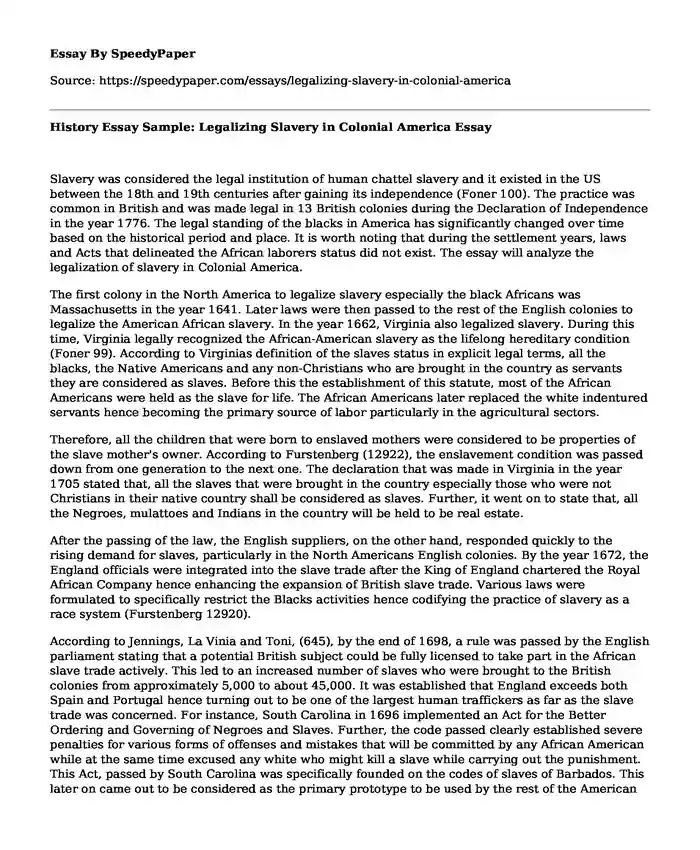
| Type of paper: | Essay |
| Categories: | History United States Slavery |
| Pages: | 3 |
| Wordcount: | 746 words |
Slavery was considered the legal institution of human chattel slavery and it existed in the US between the 18th and 19th centuries after gaining its independence (Foner 100). The practice was common in British and was made legal in 13 British colonies during the Declaration of Independence in the year 1776. The legal standing of the blacks in America has significantly changed over time based on the historical period and place. It is worth noting that during the settlement years, laws and Acts that delineated the African laborers status did not exist. The essay will analyze the legalization of slavery in Colonial America.
The first colony in the North America to legalize slavery especially the black Africans was Massachusetts in the year 1641. Later laws were then passed to the rest of the English colonies to legalize the American African slavery. In the year 1662, Virginia also legalized slavery. During this time, Virginia legally recognized the African-American slavery as the lifelong hereditary condition (Foner 99). According to Virginias definition of the slaves status in explicit legal terms, all the blacks, the Native Americans and any non-Christians who are brought in the country as servants they are considered as slaves. Before this the establishment of this statute, most of the African Americans were held as the slave for life. The African Americans later replaced the white indentured servants hence becoming the primary source of labor particularly in the agricultural sectors.
Therefore, all the children that were born to enslaved mothers were considered to be properties of the slave mother's owner. According to Furstenberg (12922), the enslavement condition was passed down from one generation to the next one. The declaration that was made in Virginia in the year 1705 stated that, all the slaves that were brought in the country especially those who were not Christians in their native country shall be considered as slaves. Further, it went on to state that, all the Negroes, mulattoes and Indians in the country will be held to be real estate.
After the passing of the law, the English suppliers, on the other hand, responded quickly to the rising demand for slaves, particularly in the North Americans English colonies. By the year 1672, the England officials were integrated into the slave trade after the King of England chartered the Royal African Company hence enhancing the expansion of British slave trade. Various laws were formulated to specifically restrict the Blacks activities hence codifying the practice of slavery as a race system (Furstenberg 12920).
According to Jennings, La Vinia and Toni, (645), by the end of 1698, a rule was passed by the English parliament stating that a potential British subject could be fully licensed to take part in the African slave trade actively. This led to an increased number of slaves who were brought to the British colonies from approximately 5,000 to about 45,000. It was established that England exceeds both Spain and Portugal hence turning out to be one of the largest human traffickers as far as the slave trade was concerned. For instance, South Carolina in 1696 implemented an Act for the Better Ordering and Governing of Negroes and Slaves. Further, the code passed clearly established severe penalties for various forms of offenses and mistakes that will be committed by any African American while at the same time excused any white who might kill a slave while carrying out the punishment. This Act, passed by South Carolina was specifically founded on the codes of slaves of Barbados. This later on came out to be considered as the primary prototype to be used by the rest of the American colonies when drafting and passing the act of black oppression into law (Furstenberg 12920).
In conclusion, men and women who were enslaved went through a severe ramification of the law. On the other hand, the free blacks also fell victims of the legalization Act since they also suffered greatly under the colonial government. Most of the Blacks seem to have a similar social station just like that occupied by the white European indentured servants. However, the Blacks station was significantly inferior hence leaving most of them highly vulnerable to potential mistreatment by their masters.
Works Cited
Foner, Eric. Give Me Liberty! An American History: Seagull Fourth Edition. Vol. 1. WW Norton & Company, 2013. Print.
Furstenberg, Francois. "Beyond freedom and slavery: autonomy, virtue, and resistance in early American political discourse." The Journal of American History 89.4 (2003): 1295-1330.
Jennings, La Vinia Delois, and Toni Morrison. " A Mercy": Toni Morrison Plots the Formation of Racial Slavery in Seventeenth-Century America." (2009): 645-649.
Cite this page
History Essay Sample: Legalizing Slavery in Colonial America. (2019, Oct 29). Retrieved from https://speedypaper.net/essays/legalizing-slavery-in-colonial-america
Request Removal
If you are the original author of this essay and no longer wish to have it published on the SpeedyPaper website, please click below to request its removal:
- Free Essay Sample on Interdisciplinary Collaboration in Shared Governance
- Essay Example - The Hunger Artist
- Free Essay: How Can The United States Lessen Its Dependence on Fossil Fuels?
- Free Essay Example: Crisis in California Analysis
- Article Review Essay Example: Some Lessons from the Assembly Line
- Marketing Essay Example: Geographic Location of the Business and Its Customers
- Free Essay Example: Nutrition and Mental Health
Popular categories




